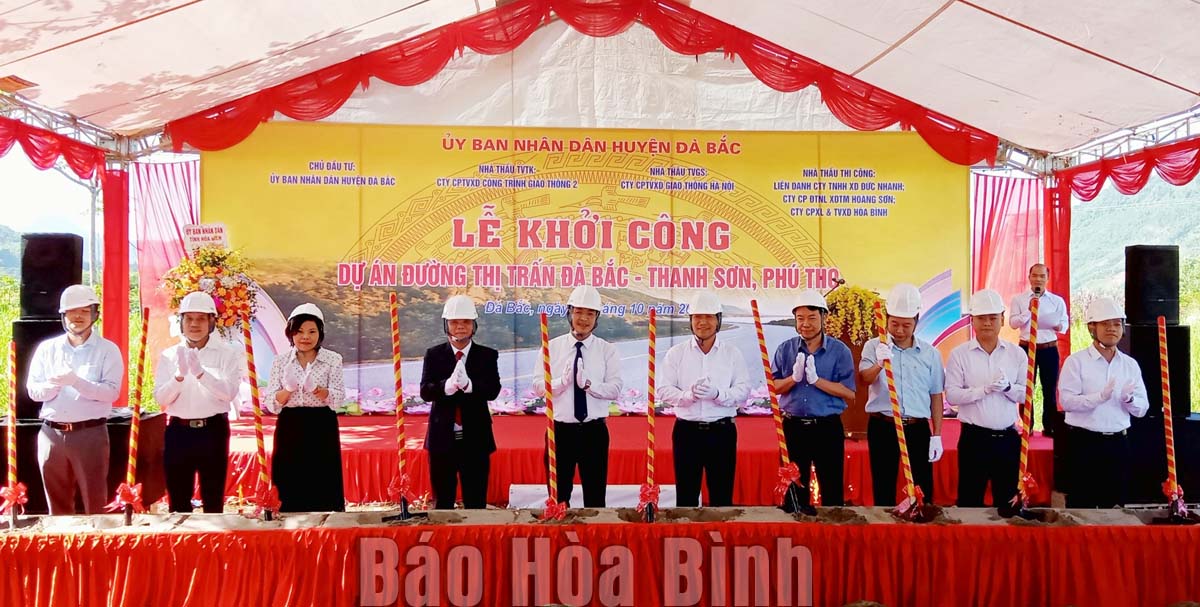
(HBO) - In the morning of October 11, in Tu Ly commune, the People's Committee of Da Bac district held a groundbreaking ceremony for the construction of the road linking Da Bac town and Thanh Son district (Phu Tho). Mr. Nguyen Van Toan, the Standing Vice Chairman of the Provincial People's Committee attended the groundbreaking ceremony.

The delegates are performing the
groundbreaking ceremony of the project.
The route is built to connect two
districts, Da Bac (Hoa Binh) and Thanh Son (Phu Tho), connecting Hao Ly
industrial cluster with the provincial road 433. The total project investment
is 250 billion VND, of which the central budget supports 200 billion dongs, the
provincial budget supports 50 billion dongs. The project is expected to be
completed in 2024.
The project consists of 2 routes:
Route 1 is 8 km long, the first point intersects with the provincial road 433
in Mu Cong sub-zone in Da Bac town; The end point is at the border between Da
Bac district and Thanh Son district. Route 2 has a length of 0.6 km, the first
point intersects with route 1 at Km5+400, the end point connects to the project
of upgrading and expanding the route from Da Bac town to Tu Ly commune. This is
a key project of the province connecting the external traffic, improving the
efficiency of land use on both sides of the route, serving the tourism
development of the tourism within Hoa Binh lake area, and promoting the
socio-economic development of the locality.
Making a speech at the
groundbreaking ceremony, Mr. Nguyen Van Toan, the Vice Chairman of the
Provincial People's Committee emphasized: In order for the project to be
implemented and completed on schedule, ensuring the quality requirements, the
local authorities need to actively complete the site clearance work. Along with
that, it is necessary to supervise the construction process, strictly manage
the progress and the quality of the works according to the approved project.
The Vice Chairman of the
Provincial People's Committee suggested that the construction contractor
maximize the capacity and experience, apply the advanced technical solutions,
and strictly comply with the State's regulations on the order and procedures
for the investment, the construction, the standards, the process, the technical
regulations, ensuring the requirements for the quality of the works.
Hoa Binh province is undergoing a dynamic transformation amid Vietnam’s national digital transition. Building on Poliburo’s Resolution No. 57-NQ/TW on breakthroughs in science, technology, innovation, and national digital transformation, the province has rolled out a wide range of practical action plans. A standout initiative is the "Digital Literacy for All” movement, an effort to ensure that no one is left behind in the digital era.
Hoa Binh province is undergoing a dynamic transformation in the wake of the national digital transformation movement. Building on Resolution No. 57-NQ/TW of the Politburo on breakthroughs in science, technology, innovation, and national digital transformation, the province has implemented a wide range of practical action plans. A standout initiative is the "Digital Literacy for All” movement ambitious effort to ensure that no one is left behind in the digital age.
With a spirit of unity and proactive problem-solving, the Party Committee, the government and the people of Dong Lai Commune (Tan Lac District) have made great strides in implementing the resolutions of the 24th Party Congress of the commune for the 2020 - 2025 term. Focusing on leadership and practical actions, the commune has brought the Party’s resolutions into daily life, creating strong impacts and pushing the local development forward.
Amid the nationwide push for digital transformation, young people in Hoa Binh Province are stepping up as dynamic pioneers, applying technology to enhance Youth Union operations and expand the reach of youth-led initiatives. Through creativity and adaptability, Youth Union organizations at all levels have introduced a series of practical solutions, contributing to modern governance and community development.
In recent years, An Nghia commune, located in Lac Son district, has stepped up administrative reform, focusing on improving the quality and efficiency of its single-window service unit for receiving and processing administrative procedures. These improvements have helped create favourable conditions for local residents and organisations to handle administrative procedures, contributing to the commune’s broader socio-economic development.
The Prime Minister-approved master plan to develop the multi-use value of forests ecosystems through 2030, with a vision to 2050, aims to improve the management and sustainable use of forest resources, create jobs, increase incomes, and improve the living standards of ethnic minorities, people in mountainous and remote areas, forest workers and those living near forests.



